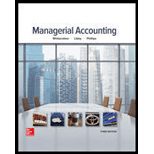
Concept explainers
(a)
Contribution Margin:
The margin of profit which is computed after considering the variable cost only and not the fixed costis known as contribution. In other words, it means the contribution made by selling the product after covering its variable cost to the company.
The contribution margin ratio.
Answer to Problem 21E
The contribution margin ratio is
Explanation of Solution
Contribution Margin Income Statement:
| Particulars | Amount |
| Revenue | |
| Total variable cost |
|
| Total Contribution Margin |
(b)
Concept introduction:
Breakeven Point:
The level of sales where the company is neither on profit nor loss is termed as breakeven point. In other words, that level of sales at which the fixed cost of the business is recovered.
To compute:
The breakeven point if the fixed cost is
Answer to Problem 21E
The breakeven point is
Explanation of Solution
| Particulars | Amount |
| Revenue | |
| Total variable cost |
|
| Total Contribution Margin |
The contribution margin ratio is
The break-even point in units is calculated as:
(c)
Concept introduction:
Target Profit:
The target profit is that profit which a company decides to achieve and this analysis helps in determinig the level of sales by which this target can be achieved.
The total sales to achieve target profit of
Answer to Problem 21E
The target sale point is
Explanation of Solution
Contribution Margin Income Statement:
| Particulars | Amount |
| Revenue | |
| Total variable cost |
|
| Total Contribution Margin |
The contribution margin ratio is
The total sales for achieving the target profit are calculated as:
(d)
Concept introduction:
Target Profit:
The target profit is that profit which a company decides to achieve and this analysis helps in determinig the level of sales by which this target can be achieved.
The sale revenue from each product to achieve target profit of
Answer to Problem 21E
The sale revenue from each product is divided as per their percentage ratio product mix which amounts to
Explanation of Solution
The total sales for achieving the target profit are calculated as:
The share of sales of Thermos A will be
The share of sales of Thermos B will be
The share of sales of Thermos C will be
Want to see more full solutions like this?
Chapter 6 Solutions
Managerial Accounting
- The Forging Department of Kahlo Metals Inc. had 1,500 tons in beginning work in process inventory (70% complete) on September 1. During September, 28,400 tons were completed. The ending work in process inventory on September 30 was 2,100 tons (90% complete). What are the total equivalent units for direct materials for September if materials are added at the beginning of the process?arrow_forwardI am trying to find the accurate solution to this financial accounting problem with the correct explanation.arrow_forwardgeneral accountingarrow_forward
 Financial Reporting, Financial Statement Analysis...FinanceISBN:9781285190907Author:James M. Wahlen, Stephen P. Baginski, Mark BradshawPublisher:Cengage Learning
Financial Reporting, Financial Statement Analysis...FinanceISBN:9781285190907Author:James M. Wahlen, Stephen P. Baginski, Mark BradshawPublisher:Cengage Learning Managerial Accounting: The Cornerstone of Busines...AccountingISBN:9781337115773Author:Maryanne M. Mowen, Don R. Hansen, Dan L. HeitgerPublisher:Cengage LearningPrinciples of Accounting Volume 2AccountingISBN:9781947172609Author:OpenStaxPublisher:OpenStax College
Managerial Accounting: The Cornerstone of Busines...AccountingISBN:9781337115773Author:Maryanne M. Mowen, Don R. Hansen, Dan L. HeitgerPublisher:Cengage LearningPrinciples of Accounting Volume 2AccountingISBN:9781947172609Author:OpenStaxPublisher:OpenStax College Cornerstones of Cost Management (Cornerstones Ser...AccountingISBN:9781305970663Author:Don R. Hansen, Maryanne M. MowenPublisher:Cengage Learning
Cornerstones of Cost Management (Cornerstones Ser...AccountingISBN:9781305970663Author:Don R. Hansen, Maryanne M. MowenPublisher:Cengage Learning Survey of Accounting (Accounting I)AccountingISBN:9781305961883Author:Carl WarrenPublisher:Cengage Learning
Survey of Accounting (Accounting I)AccountingISBN:9781305961883Author:Carl WarrenPublisher:Cengage Learning




